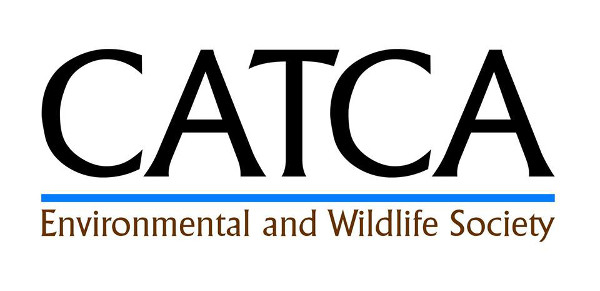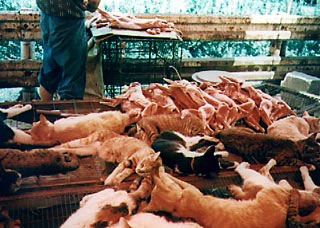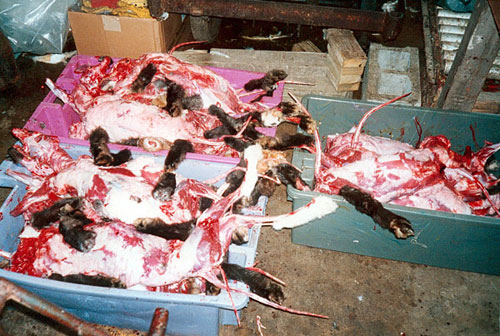

Cat and Dog fur from China
Fur from cats and dogs are produced in China.
It is estimated that more than two million cats and dogs are brutally slaughtered each year in China alone to supply the main markets in Europe and Russia.
To kill a dog, the butcher ties a metal wire around its neck, then stabs the dog in the groin area. The butcher then skins the dog, often while the dog still lives.
Often these dogs are so tamed and used to humans, that they wag their tails to these people while they tied them to a post, fence or stick on the ground, before starting to torture the animal.
If the dogs bleed to dead or they choke to dead with the metal wire, they are "lucky" not to be been skinned alive.
The dogs cries and screams are heard by other dogs awaiting the same horrific fate. Sometimes they are tied by a rope in the middle of the street and with a small knife, start to cut and pull off the skin of the back legs.
The short-haired cats and the German shepherd dogs are the mist valuable to the breeders.
Cats have a terrible death too. Butchers hang cats to kill them. Sometimes, they hang the cats, then pour water into their open mouths until the cats drown. Many cats are stolen from homes and just as the dogs, often wear collars with tags on them... others are breed in extremely poor conditions.


Skining
When they transport the cats and dogs, the poor animals are all crowded into small wooden boxes, or metallic cages, without food, nor water and thrown one on top of each other. Upon arrival to their final destination, they are thrown from the top of buses or vans to the ground, breaking the cats and dogs legs and tails and causing them severe injuries and wounds.
But this doesn't happen in China only: Recently some HSI investigators, discovered two cat and dog breeders in Belgium, where rounded street cats and dogs ended up and were kept at animal farms where they are slaughtered for their fur.
Often they were skinned alive to prevent the furs losing their condition after the animals' death.
Belgium became the fifth EU member state in 2004 to introduce an import ban on cat and dog fur, but the sale of such products remains legal in the rest of the EU.

Product of cruelty
The US has banned it, so has Australia, Denmark, France, Italy, Belgium and Greece, but until there is a full EU ban 2 million cats and dogs will suffer and the trade will continue.
The HSI (Humane Society International), has found cat and dog fur for sale in Germany, France, Italy, Spain, Denmark, Belgium and in the Netherlands.

Production line for cats
Some chemical analyses done to a toy figure and a cat figurine from China, were found with excessive levels of chromium which may affect children's DNA.
Dog and cat fur may be labeled by the foreign manufacturers as the following:
Dog fur may be called: Gae-wolf, Sobaki, Loup d'Asie(wolf of Asia), Goupee, China wolf, Pommern wolf, Asiatic raccoon dog, Corsac fox, Dogues du Chine, Asian jackal
Cat fur may be called: Rabbit, Wildcat, Goyangi, Mountain cat, Housecat, Katzenfelle
Small animal figurines are often made with dog or cat fur, but are misrepresented by the manufacturers as being of rabbit fur obtained as a by-product of the food industry in China.

Bloody bodies left behind
The Dog and Cat Protection Act of 2000 prohibits imports or exports of dog or cat fur containing products into or out of the United States
- If a review of the import documents and/or initial examination of a shipment indicates that an importation may contain dog or cat fur, Customs will send samples of the shipment to a laboratory for analysis to determine the species of the fur.
- Violators of the Act will be fined up to $10,000 for each item containing dog or cat fur.
- A reward of $500 will be offered for any information leading to the successful prosecution for violations of the Act.
If you are in the States, and would like to report a possible violation of the Dog and Cat Protection Act of 2000, please contact the Commercial Enforcement Branch of Trade Programs, Office of Field Operations of the United States Customs Service at (202) 344-1320.
From 2006 the EU planned to ban all cat and dog fur in its territory. In June 2007 the EU voted in favor of the ban. The ban on cat and dog fur was officially implemented in December 31, 2008 in all the EU countries.
Canada still refuses to take action in this matter, specially after the EU ban the importation of seal products in their territory came in effect just few weeks ago.
Translations
- - -You can help to keep us doing this high level personal and active lobbying!
Help Yupi

WAD

Ericka Ceballos is the proud Canadian Ambassador of World Animal Day. Click on the WAD logo above to check for the events that we will hold to celebrate the animals in Canada.
AD-AV Award!

Click to view larger
Campaigns Against the Cruelty to Animals


Follow us on Twitter!
Click on the button link above for important animal news, events and alerts.
Contact Info
Ericka
PO Box 16021
617 Belmont Street
New Westminster
British Columbia
V3M 6W6
Canada
Email Us!